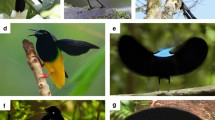Abstract
Homing pigeons have been subject of various studies trying to detect magnetic material which might be involved in magnetic field perception. Here we focus on the upper-beak skin of homing pigeons, a region that has previously been shown to contain nerves sensitive to changes of the ambient magnetic field. We localized Fe3+ concentrations in the subcutis and identified the material by transmission electronmicroscopy (TEM) as aggregates of magnetite nanocrystals (with grain sizes between 1 and 5 nm). The particles form clusters of 1–3 μm diameter, which are arranged in distinct coherent elongated structures, associated with nervous tissue and located between fat cells. Complementary low-temperature magnetic measurements confirm the microscopic observations of fine-grained superparamagnetic particles in the tissue. Neither electron-microscopic nor magnetic measurements revealed any single-domain magnetite in the upper-beak skin tissue.
Similar content being viewed by others
References
Beason RC, Semm P. 1987 Magnetic responses of the trigeminal nerve system of the bobolink (Dolichonyx oryzivorous). Neurosci Lett 80, 229.
Blakemore RP. 1975 Magnetotactic bacteria. Science 190, 377–379.
Blanco-Mantecón M, O'Grady K. 1999 Grain size and blocking dis-tributions in fine particle iron oxide nanoparticles. J Magn Magn Mater 203, 50–53.
Bubien-Waluszewska A. 1981 The cranial nerves. In: Form and Function in BirdsNew York: Academic Press; 385–438.
Butler RF, Banerjee SK. 1975 Theoretical single-domain grain size range in magnetite and titanomagnetite. J Geophys Res 80, 4049–4058.
Holtkamp-Rötzler E. 1998 Verhaltensphysiologische, 6ysikalische und neuroanatomische Befunde zur Magnetfeldperzeption bei Brieftauben (Columba livia). Inaugural-Dissertation (Fachbere-ich Biologie, Universität Frankfurt) 177 pp.
Ising G. 1945 Die physikalische Möglichkeit eines tierischen Orien-tierungssinnes auf der Basis der Erdrotation. Ark Mat Astron Fys 32A, 1–23.
Lowenstamm HA. 1962 Magnetite in denticle capping in recent chitons (Polyplacophora). Geol Soc Am Bull 73, 435–438.
Luo Nagel SR, Rosenbaum TF, Rosensweig RE. 1991 Dipole interactions with random anisotropy in a frozen ferrofluid. Phys Rev Lett 67, 2721–2725.
Presti D, Pettigrew JD. 1980 Ferromagnetic coupling to muscle re-ceptors as a basis for geomagnetic field sensitivity in animals. Nature 285, 99–1011
Sappey R, Vincent E, Hadacek N, Chaput F, Boilot JP, Zins D. 1997 Nonmonotonic field dependence of the zero-field cooled magne-tization peak in some systems of magnetic nanoparticles. Phys Rev B56, 14551–14559.
Semm P, Nohr D, Demaine C, Wiltschko W. 1984 Neural basis of the magnetic compass: interactions of visual, magnetic and vestibular inputs in the pigeon's brain. J Comp Physiol A155, 283–288.
Tanka Y, Berschauer JA. 1969 Application of the Pearl's method for iron staining to se1ions embedded in epoxy resin. Stain Technol 44, 255–256.
Walcott C, Gould JL, Kirschvink JL. 1979 Pigeons have magnets. Science 205, 1027–1029.
Walker MM, Diebel CE, Haugh CV, Pankhurst PM, Montgomery JC, Green CR. 1997 Structure and function of the vertebrate magnetic sense. Nature 390, 371–376.
Wiltschko R, Wilschko W. 1995 Magnetic Orientation in Animals. Berlin: Springer-Verlag.
Winklhofer M, Fabian K, Heider F. 1997 Magnetic blocking tem-peratures of magnetite calculated with a three-dimensional mi-cromagnetic model. J Geophys Res B102, 22, 695–22.
Author information
Authors and Affiliations
Rights and permissions
About this article
Cite this article
Hanzlik, M., Heunemann, C., Holtkamp-Rötzler, E. et al. Superparamagnetic Magnetite in the Upper Beak Tissue of Homing Pigeons. Biometals 13, 325–331 (2000). https://doi.org/10.1023/A:1009214526685
Issue Date:
DOI: https://doi.org/10.1023/A:1009214526685




